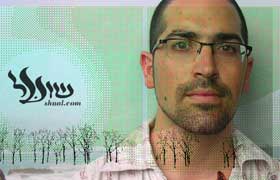 I met Mushon Zer-Aviv at ars electronica last year where he was presenting two projects: Upgrade!, an international network of gatherings around new-media, and ShiftSpace, an open-source meta-layer built above the web. A few weeks later, Mushon’s path crossed mine again. He was presenting You Are Not Here at Conflux, a festival of psychogreography held in New York each year.
I met Mushon Zer-Aviv at ars electronica last year where he was presenting two projects: Upgrade!, an international network of gatherings around new-media, and ShiftSpace, an open-source meta-layer built above the web. A few weeks later, Mushon’s path crossed mine again. He was presenting You Are Not Here at Conflux, a festival of psychogreography held in New York each year.
Mushon is a guy who never stops and makes us all feel lazy and useless. He designs, teaches, writes for mags, acts and netarts within new media. He is interested in particular in challenging the perception of territory and borders and the way they are shaped through politics, culture, globalization and the world wide web.
He lives with his wife and cat in New York and i’m really happy that he found some time to answer my questions.
Mushon, i first met you in Austria, you were presenting (between others)the activities of Upgrade! The Upgrade! network is growing and getting more active as time goes by. What motivated its creation? How did it develop? What are its objective?
Upgrade! started in 1999 by new media artist Yael Kanarek when she and three more friends got lonely and decided to meet in a bar in the East Village to discuss each other’s works, these unofficial meetings developed and expanded and Yael started holding these meetings at Eyebeam Center for Art & Technology. In 2003 Upgrade started to expand when participants in the New York node and other friends of Yael opened similar nodes in Vancouver, Montreal, Boston, Seoul, Munich and at all more than 20 cities around the world. In 2005 I started the Tel-Aviv node, currently run by the Sala-Manca group. Since I moved to New York I have been more involved in the international level.
At the end of November 2006, we’ve met for the second Upgrade International gathering in Oklahoma City where we all exhibited, presented, held workshops and lectures around the theme of DIY. This was one of the most exciting events I’ve been to and I kept saying to myself how proud I am to be a part of this (I was also fortunate to work on the catalog). Every morning for the 4 days of the event we would meet for breakfast and discuss the network. We would learn about each other’s nodes and think of ways to develop the international level.
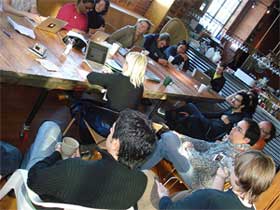 Each node works a bit differently and reflects the culture and interests of its local community. For example, the Scotland node invites both artists and other specialists to present back-to-back it also moves every month between Glasgow and Dundee, the Chicago node holds its meetings at restaurants and acts as a meeting point for different new media academics, the Belgrade node serves as an umbrella to different art organizations, the Boston node is very tied to the practice and artist-base of Turbulence, the organization that runs it and the Salvador and Tel-Aviv/Jerusalem nodes are very interested in media activism and social change, and so on…
Each node works a bit differently and reflects the culture and interests of its local community. For example, the Scotland node invites both artists and other specialists to present back-to-back it also moves every month between Glasgow and Dundee, the Chicago node holds its meetings at restaurants and acts as a meeting point for different new media academics, the Belgrade node serves as an umbrella to different art organizations, the Boston node is very tied to the practice and artist-base of Turbulence, the organization that runs it and the Salvador and Tel-Aviv/Jerusalem nodes are very interested in media activism and social change, and so on…
On the larger perspective it seems like Upgrade is going through the three classic models of networks, it started as a centralized network, with Yael’s original NY node, continued to a decentralized network with different organizers networking between themselves and running local nodes and communities. One of our goals right now is to reach that third model of the distributed network (the same one behind the internet protocol that allows us to communicate) meaning – peer to peer communication and collaboration between artists from different nodes.
On the last day of the International gathering last month, Dan Phiffer, my partner on many projects, have presented his Postnational Foundation project where he attempts to challenge nationalistic approaches to politics through small local interventions. I think we were all very inspired by his presentation and sympathized with the ‘think global/act local’ approach. It is not accidental that the nodes are named by cities and not nations, we do see ourselves as a postnational network. Upgrade is a great platform for us to challenge globalization and offer better models of global networking.
Can anyone set up an Upgrade! in his or her own city? What are the rules? Any condition to fulfil?
We always try to make up rules, yet we keep deciding not to. Up to now we have a thriving network with only one case of a node loosing contact after one event, as much as it is not desirable we have decided it is ok, nodes will naturally have various lifespans. We decided to try not to make rules. If it breaks, we’ll fix it. The way Upgrade started, the way it evolved and the way we would like it to keep growing is through the social networks of it’s members, we’re all friends of friends of friends. This narrows it down to one simple rule – you want to start an Upgrade? First become our friend :)
Do you see the internet as a public space? And how does ShiftSpace -that you developed together with Dan Phiffer- fit in the picture?
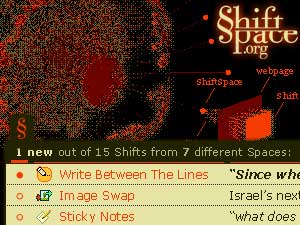 Dan and I met in ITP, I come from a design background and he from creative web hacking. We both really love the web and see it as the most important model for a future postnational world. That’s why we’re also very concerned about the main paradigm of the web, namely privatization. While the discourse about the web is full of superlatives implying freedom and sharing, we find ourselves constantly bouncing into new walls and boundaries online. The web is built as a huge set of private spaces – while the internet protocol is indeed distributed, the DNS (Domain Name System) protocol is totally centralized – meaning the control of the page content (no matter how interactive or web 2.0-ish it is) always in the hands of a single private power holder.We are trying to challenge this approach and make a point by not just questioning the web’s power structures, but prove that we can build an interesting and useful tool.
Dan and I met in ITP, I come from a design background and he from creative web hacking. We both really love the web and see it as the most important model for a future postnational world. That’s why we’re also very concerned about the main paradigm of the web, namely privatization. While the discourse about the web is full of superlatives implying freedom and sharing, we find ourselves constantly bouncing into new walls and boundaries online. The web is built as a huge set of private spaces – while the internet protocol is indeed distributed, the DNS (Domain Name System) protocol is totally centralized – meaning the control of the page content (no matter how interactive or web 2.0-ish it is) always in the hands of a single private power holder.We are trying to challenge this approach and make a point by not just questioning the web’s power structures, but prove that we can build an interesting and useful tool.
ShiftSpace is an open source platform for the social extensions of websites. It is if you will, a transparent layer above any website where users can leave notes, discuss, protest, create art, and deeply explore the interactive potential of the web.
By installing the plug-in’s current public beta version 0.07 (which we launched for the first day of 2007) users can use the ‘Notes’ space (application for ShiftSpace) to leave post-it notes on websites, use the ‘ImageSwap’ space to switch any image on the web with any other image, and use the latest addition ‘SourceShift’ to modify the html source of any page. We call these modifications shifts. When a user browse to a shifted page, she gets notified by a little icon, she can then click the
We are currently working on many new spaces and on a feature called ‘trails’ which would allow users to link shifts together and create information-maps on the web.ShiftSpace challenges the privatized interface paradigm and hopes to become an attractive platform for net artists, researchers, activists, poets, technologists and the everyday users. The Meta-Web concept has not managed to ‘catch’ yet, though many attempts have been made on it from the days of Third-Voice through GreaseMonkey to the proliferation of meta-web 2.0 annotation tools that are available out there.
ShiftSpace is a very young and ambitious project, we try to learn from the successes and mistakes of our predecessors and provide a true public space on the web. It is a Wild Wild Web out there and we’re trying to make the platform as stable and yet as open as we can.
Has the shiftspace project evolved since I first heard the presentation you made at Ars Electronica in September 2006?
Definitely! First of all, we had four more releases since then (with v0.08 is coming soon too) and have just launched the new ShiftSpace.org which is wider and more comprehensive than the previous site. The new site also allows users to watch and subscribe to RSS feeds of shifts created by the vast user community.
We have been giving more presentations to spread the word and have been throwing ‘installation parties’ where participants were invited to install a public spaces on their laptops. We are currently working with Turbulence to start a unique commission program to support artists creating new parasitic net art and using ShiftSpace as a platform. This can become the moment we’ve been working towards, where ShiftSpace becomes an open-ended creative platform, shared and developed by a wide community.
We are looking for more people to join us in working on it. It can be as simple as using the system, being creative with it, and also reporting bugs from time to time when they appear (and bare with us while they will most certainly appear…). You can also join by developing new spaces for ShiftSpace, or best – for the web gurus out there, we are looking for developers to help us work on the core system itself. We are pretty serious about the open source model and are inspired by the Wikipedia foundation. We hope to achieve a stage when we could hold elections for the lead of the project. We will then hopefully compete with peers who are as enthusiastic and committed as we are to the future of the (meta)web.
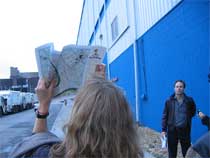
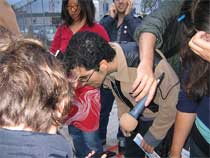 You Are Not Here during the Conflux festival
You Are Not Here during the Conflux festival
You Are Not Here invites people to a touristic tour of Baghdad throughthe streets of New York. What was the impetus for this project? What doyou think New Yorkers can learn about their own city and about Baghdad with this project?
For me YANH has a lot to do with ShiftSpace. While ShiftSpace adds an information layer above the online space, YANH adds one above the urban space. We were generally dissatisfied with the way mainstream media communicates terms like ‘Baghdad’ and ‘Iraqis’, we were feeling these terms have lost their human scale. YANH attempts to allow a one-to-one scaled experience of Baghdad.
Accompanied by a two-sided NY/Baghdad map, the participants find the situated YANH signs in the streets of NY and call the YANH Baghdad tourist center to get the audio tours. Ubiquitous computing and specifically cellphones merges physical presence with mediation, and that’s it’s power, YANH is built around a tension between the two. Specifically, the guide for these Baghdad locations is very American. While you get to “walk in Baghdad”, to experience information in human scale, this western guide reflects again the way we’re all guided through information in mainstream media. This also adds a certain repulsive preview of culturally colonized Baghdad. The tension of tourism/colonialism is an inherent part of the project. I hope you got to experience this when you participated in the Conflux tour last September. NY based readers can try it too by downloading the map from the website and simply go out and enjoy Baghdad.
Can you tell us something about the new version of YANH: a tour of Gaza through the streets of Tel-Aviv?
Definitely. As an Israeli, this is something I’m specifically excited about. Four members of the original YANH team members (Kati London, Thomas Duc, Dan Phiffer and myself) are currently working on this second YANH project. This time reflecting Gaza and Tel-Aviv in a similar manner. Though geographically close (only two hours ride) these two cities are both emotionally and politically detached. This political and emotional detachment is a complicated issue, with some history. While the disengagement of Israel from the Gaza strip in the summer of 2005 was thought to open a new hope for Gazan civilians, it has practically turned Gaza to the biggest jail in the world. Where once Gazans used to work in Israel, now that the borders are closed the situation in Gaza deteriorates every day. It’s a vicious circle in which the Israeli air-force keeps shelling the city to ‘retaliate’ for rocket launching from Gaza to Israel. You see… most Israelis are tired from the 40 years long occupation and want to see it end. Yet, in Tel-Aviv the general mind-frame is that after the disengagement we are not IN Gaza anymore and therefore are no longer responsible for it. This is something we want to address through the new YANH.
One thing we’re doing differently this time is that we are not going to have an American or an Israeli narrator, but rather work with people from Gaza. We have just started working with Laila El-Haddad the talented writer of the fascinating blog Raising Yousuf, Unplugged: diary of a Palestinian mother. It is too early to say where would this collaborations lead the project, but we have high hopes for it. We are interested in the potential to turn Tel-Aviv into a situated media platform for geolocated audio blogging from Gaza. You Are Not Here: A Tour of Gaza through the Streets of Tel-Aviv will be launched in April, and the map will be printed in the 4th issue of Block Magazine. We are thinking of future episodes for YANH and are in contact with our Korean Upgrade friends trying to promote a tour of P’yongyang through the streets of Seoul.
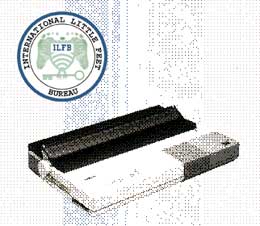 How about the Little Feet Bureau? What did you try to achive with that project? Did you intend to raise the attention to online surveillance? Which kind of audience did you have in mind when you developed the LFB?
How about the Little Feet Bureau? What did you try to achive with that project? Did you intend to raise the attention to online surveillance? Which kind of audience did you have in mind when you developed the LFB?
By now you can probably pick an overarching theme I’m working with. You know, growing up in Israel I always had regional maps around me, each one of them looked different… I managed to reach quite a grow up age without knowing what are the borders of my country. In a way I still don’t. It has become my own private border conflict. That is why I’m so drawn to the internet and that is why I’m so interested in Postnationalism.
The Little Feet Bureau is concerned with exactly that – the tension between the Postnational tendencies of the web and the paranoid tendencies of national information agencies. Governments and national ideologies secretly surveil innocent internet traffic trying to project and justify their fears and construct fantastic narratives of terrorism, extremism and instability through bundeling of ‘dangerous keywords’. For me this is the peak of the tension the core of the digital border conflict.
Toshi Ozawa, David Nolen and myself have created the Little Feet Bureau, an independent agency providing surveillance services for different governments. LF’s dot-matrix printers are personalized to the client’s ideology and print accusation letters to suspect users based on these paranoid keyword narratives. Essentially, these are paranoia machines – embodying national fears and cultural segregation into computer algorithms.
Did we do it to inform and raise attention about online surveillance? I’m not sure. Actually, Little Feet was launched in an Upgrade! New York event we held in Eyebeam. The title of the event was: We Passion Power and Control: the dark desires of art under surveillance. We also had presentations by of in(security) and of Generative Social Networking (both worth a WMMNA post). When we opened it to discussion we asked exactly that – did we do that to educate? to inform? to raise attention? or was there another thing? There is a constant love/hate relationship between artists and power. On one hand we want ‘to protest against them’, ‘to raise awareness’, ‘to reveal the injustices’ but on the other hand we simply envy that power, we WANT to posses the power of surveillance, we protest against it both because we think it’s wrong and because we actually wish WE had this enormous power at our disposal.
I saw a similar thing happen at the Three Cities Against The Wall exhibition (where Less Rain studio and myself presented Graffiti Studio: Separation Wall). Artists both cried against the separation wall Israel is building in the west bank but many works actually longed for that power. There was a certain hidden desire kind of saying “I wish I could build such an extraordinary spectacle”.
Atlas Gloves is a DIY physical interface for controlling 3D mappingapplications like Google Earth. Why did you and Dan decide to open the code and let people re-create the gloves. Which kind of improvement do you think other users can bring to the gloves?
This is actually a funny story. Dan and I were in our first semester in ITP in Tom Igoe‘s Introduction to Physical Computing class. Both of us spoiled software brats were a bit afraid of electronics and searched a way in the realms of the physical away from all these scary electrifying breadboards. Plus we are both very much about distribution, and have decided to build a cheap video tracking based hand gesture interface for Google Earth. The fun part is that it’s just two ping-pong balls and keychain lighters – about $8 worth of a fancy Minority Report’ish interface.
Opening the source was an obvious decision for us, first of all we did it in the Processing programming language which is in itself opensource so it seemed only fair to make our software open too. But we were trying to make a point for low-tech as well. A lot of the spectacle of electronics involves how much it costs, these high-end interfaces demonstrate both control and wealth. Atlas Gloves is a free software and almost free hardware, and it works well. And if it doesn’t work for you, you can fix it yourself, and if you’re not into Google Earth or you want to use it for something else, than the code is yours to play with. Actually John Craig Freeman, an artist from Upgrade Boston is currently trying to see if he can use Atlas Gloves for his Second Life based artworks. That’s exactly the beauty of open source.
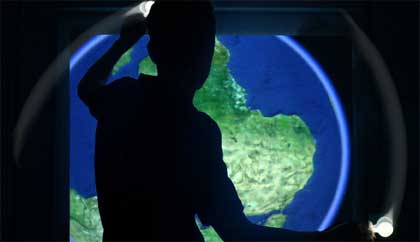 Are there researchers or artists whose work you find particularly inspiring? Why?
Are there researchers or artists whose work you find particularly inspiring? Why?
As you probably noticed I am constantly inspired by the Upgrade network and the loads of talent, inspiration and leadership it has to offer. My professors are a great inspiration, Clay Shirky is very supportive of ShiftSpace and was there from the beginning, Raffi Krikorian was in the background of Little Feet, Frank Lantz, Nancy Hechinger, Alex Galloway, the list is long… For better or worse I am inspired by what’s going on in the world and specifically by the way it is mediated. I enjoy some magazines, such as Bidoun: Art and Culture from the Middle East, that have inspired You Are Not Here a lot. I have designed and am involved in Maarav, an Israeli art, culture and media magazine that is a great inspiration for me. It is very politically involved and like Bidoun is dedicated to art from the middle east (English version coming very soon). I have been watching a lot of documentaries lately, Adam Curtis‘s ‘Century of the Self’ and ‘The Power of Nightmares’ are both must sees, John Pilger got me quite depressed, some Israeli documentary movies like Avi Mograbi‘s ‘Avenge But One of My Two Eyes’ is very strong, so is Juliano Mer-Khamis’ ‘Arna’s Children‘.
I am extremely inspired by my good friends the Sala-Manca group. They are inspiring artists that have managed while maintaining total independence to become a leading force in the Israeli contemporary art scene. They publish a magazine, curate exhibitions and art events, run no-org.net where they publish net art exhibitions, hold workshops, run Upgrade! Tel-Aviv/Jerusalem and lately have also become parents. They are truly amazing, you should definitely check them out!
I really can’t figure out how you do it all: study at itp, have a webdesign studio, create cool project and follow Upgrade! Do you have timeto dedicate to anything else?
My wife would love this question (did she write it?). The truth is that I get by with a little help from my friends. All the projects I mentioned are at least 50% the work of the super talented people I have got to work with. First of all Shual studio is also in the good hands of my partner (and great inspiration) Guy Saggee. I always work with more people, for me that’s the best way to work. That’s what Upgrade is all about, that’s also why I went to ITP, collaboration is ITP’s secret. I only can’t believe it’s almost over. We’re graduating really soon and I still have a huge list of ITPers I would have loved to work with… Andrew Schneider, Christian Croft, Ariel Efron, Chetan Mengat, Zach Layton, Britta Riley, Stefan Hechenberger, Jenny Chowdhury, Josh Klein, Heather Dewey Hagborg… it’s a long list of people I have not collaborated with yet. I hope we will get the time for that too, after all, we are (comparably) young, right?
Thanks Mushon!
Podcast of the presentation of Upgrade at ars electronica.
